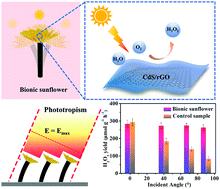当前位置:
X-MOL 学术
›
Energy Environ. Sci.
›
论文详情
Our official English website, www.x-mol.net, welcomes your feedback! (Note: you will need to create a separate account there.)
The bionic sunflower: a bio-inspired autonomous light tracking photocatalytic system
Energy & Environmental Science ( IF 32.5 ) Pub Date : 2021-5-26 , DOI: 10.1039/d1ee00587a Jingjing Qin 1, 2, 3, 4, 5 , Kaibin Chu 1, 2, 3, 4, 5 , Yunpeng Huang 1, 2, 3, 4, 5 , Xiangmiao Zhu 1, 2, 3, 4, 5 , Johan Hofkens 6, 7, 8, 9, 10 , Guanjie He 6, 11, 12, 13, 14 , Ivan P. Parkin 6, 11, 12, 13, 14 , Feili Lai 6, 7, 8, 9, 10 , Tianxi Liu 1, 2, 3, 4, 5
Energy & Environmental Science ( IF 32.5 ) Pub Date : 2021-5-26 , DOI: 10.1039/d1ee00587a Jingjing Qin 1, 2, 3, 4, 5 , Kaibin Chu 1, 2, 3, 4, 5 , Yunpeng Huang 1, 2, 3, 4, 5 , Xiangmiao Zhu 1, 2, 3, 4, 5 , Johan Hofkens 6, 7, 8, 9, 10 , Guanjie He 6, 11, 12, 13, 14 , Ivan P. Parkin 6, 11, 12, 13, 14 , Feili Lai 6, 7, 8, 9, 10 , Tianxi Liu 1, 2, 3, 4, 5
Affiliation

|
Developing a self-adapting photocatalytic system that efficiently captures light all day is not only a dream but also a challenge. Here, we report a ‘bionic sunflower’ based on a light-responsive smart hydrogel, which can spontaneously track and orient itself directionally to a light source, mimicking phototropism in, e.g., plants. As a novel photocatalytic system, it can efficiently recover the oblique-incidence energy-density loss and maintain photocatalytic efficiency at the maximum level at any random incidence angle from 0 to 90°. By taking the photocatalysis of H2O2 generation as an example, the bionic sunflower displays a high H2O2 yield rate of 262.1 μmol g−1 h−1 under 90° irradiation, as compared with the same photocatalytic system without phototropism (83.5 μmol g−1 h−1). Theoretical analyses with COMSOL Multiphysics simulation and density functional theory (DFT) calculations reveal the mechanism behind the actuation motion that triggers the bending of the bionic sunflower and determine the active sites for H2O2 generation during photocatalysis. This work proposes a novel photocatalytic concept to boost any traditional photocatalytic reaction by optimally using the solar energy from the sun's passage.
中文翻译:

仿生向日葵:受生物启发的自主光跟踪光催化系统
开发一种能够全天高效捕捉光线的自适应光催化系统不仅是一个梦想,也是一个挑战。在这里,我们报告了一种基于光响应智能水凝胶的“仿生向日葵”,它可以自发地跟踪和定向到光源,在例如植物中模仿向光性。作为一种新型光催化体系,它可以有效地恢复斜入射能量密度损失,并在 0 到 90° 的任何随机入射角下将光催化效率保持在最大水平。以光催化生成 H 2 O 2为例,仿生向日葵的 H 2 O 2产率高达 262.1 μmol g -1 h-1在90°照射下,与没有向光性的相同光催化体系(83.5 μmol g -1 h -1)相比。使用 COMSOL Multiphysics 模拟和密度泛函理论 (DFT) 计算进行的理论分析揭示了触发仿生向日葵弯曲的驱动运动背后的机制,并确定了光催化过程中生成H 2 O 2的活性位点。这项工作提出了一种新的光催化概念,通过优化利用来自太阳通道的太阳能来促进任何传统的光催化反应。
更新日期:2021-06-18
中文翻译:

仿生向日葵:受生物启发的自主光跟踪光催化系统
开发一种能够全天高效捕捉光线的自适应光催化系统不仅是一个梦想,也是一个挑战。在这里,我们报告了一种基于光响应智能水凝胶的“仿生向日葵”,它可以自发地跟踪和定向到光源,在例如植物中模仿向光性。作为一种新型光催化体系,它可以有效地恢复斜入射能量密度损失,并在 0 到 90° 的任何随机入射角下将光催化效率保持在最大水平。以光催化生成 H 2 O 2为例,仿生向日葵的 H 2 O 2产率高达 262.1 μmol g -1 h-1在90°照射下,与没有向光性的相同光催化体系(83.5 μmol g -1 h -1)相比。使用 COMSOL Multiphysics 模拟和密度泛函理论 (DFT) 计算进行的理论分析揭示了触发仿生向日葵弯曲的驱动运动背后的机制,并确定了光催化过程中生成H 2 O 2的活性位点。这项工作提出了一种新的光催化概念,通过优化利用来自太阳通道的太阳能来促进任何传统的光催化反应。


























 京公网安备 11010802027423号
京公网安备 11010802027423号